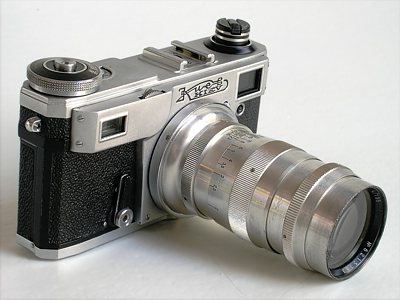
|
Kiev — a Soviet Contax Not just a clone |

| Back to Vintage Cameras |
|
Kiev was, I believe, better supported with interchangeable lenses than any other Soviet-made camera (except those using the M42 universal screw mount). Here the camera is shown with a 135mm/4.0 Yupiter-11 (#6215383). The lens is compact (a true telephoto) and quite ugly-looking. It still couples with the thumbwheel, but the latter cannot overcome the torque, magnified by some internal transmission ratio. Therefore the lens (unlike standard Kiev/Contax ones) has its own focusing ring. When you turn it, the thumbwheel also turns. |

|
|
From Contax Kiev inherited two ergonomic design flaws.
In all Kiev lenses I've seen focusing also rotates the front lens element, together with the aperture scale. The scale may easily end up at the bottom side of the lens barrel; to set the aperture you have to turn the camera upside down. The focus wheel is quite difficult to operate without your fingers obstructing the rangefinder window. On the other hand, the rangefinder itself is very accurate (good enough for long and large-aperture lenses with small depth of field) and quite easy to use. The viewfinder, however, is small, dark, and difficult to use with glasses. I'm happy I don't have to use Kiev (or Contax) as my basic camera. From a collector's viewpoint these are just conversation items, though. And now we come to the painful bit. Generally, the late-period Kievs are less well built, finished, and tuned than the earlier ones (which were not shining either). The one shown here is perhaps the worst I have handled: this is no longer the German engineering, but the shoddy, Communist imitation. I have used some pre-Seventies Kievs and they were better. In the Seventies in Poland a Kiev was considered junk, unless you hired a technician who would spend a week bringing a factory-fresh camera into shape, which could include custom-making or cannibalizing parts. Some people were actually doing that, but most simply wouldn't bother. Camera specs at a glance These were quite impressive specs at the time.
Web resources
| |

| Back to Vintage Cameras |
| Home: wrotniak.net | Search this site | Change font size |
| Posted 2003/12/07; last updated 2018/09/12 | Copyright © 2003-2007 by J.Andrzej Wrotniak. |